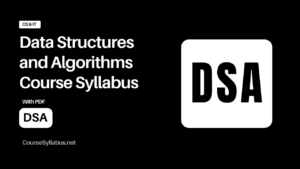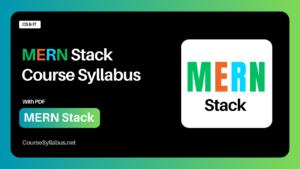The MEAN stack is a collection of JavaScript-based technologies used to develop web applications. The acronym “MEAN” stands for MongoDB, Express.js, Angular, and Node.js. Each component in the MEAN stack brings its own set of functionalities and advantages, allowing developers to build robust and scalable applications entirely with JavaScript.
- MongoDB: NoSQL database, JSON-like format, scalable, high performance.
- Express.js: Minimalist web framework for Node.js, simplifies server-side tasks.
- Angular: Front-end framework by Google, follows MVC, and enables dynamic SPAs.
- Node.js: Server-side JavaScript runtime, event-driven, high performance.
MEAN Stack Course Syllabus
Module 1: Introduction to Web Development and MEAN Stack
- Overview of web development technologies and methodologies
- Introduction to the MEAN stack (MongoDB, Express.js, Angular, Node.js)
- Advantages and use cases of the MEAN stack
- Setting up the development environment (installing necessary tools and dependencies)
Module 2: MongoDB
- Understanding NoSQL databases and MongoDB’s role in the MEAN stack
- Installation and setup of MongoDB
- CRUD operations in MongoDB (Create, Read, Update, Delete)
- Working with MongoDB collections and documents
- Indexing and query optimization techniques
- Schema design and data modeling best practices
Module 3: Express.js
- Introduction to Express.js and its role as a web application framework for Node.js
- Setting up an Express.js application
- Handling HTTP requests and responses
- Creating RESTful APIs with Express.js
- Implementing middleware for request processing, error handling, and authentication
- Integrating Passport.js for authentication and authorization in Express.js applications
Module 4: Angular Basics
- Introduction to Angular framework and its architecture
- Installing Angular CLI and creating a new Angular project
- Components, modules, and services in Angular
- Angular templating and data binding
- Directives and pipes for manipulating the UI
- Introduction to TypeScript and its usage in Angular applications
Module 5: Angular Advanced
- Angular routing and navigation for building single-page applications (SPAs)
- Forms and reactive form handling in Angular
- Data communication with HTTP client and observables
- Implementing authentication and authorization mechanisms in Angular applications
- Inter-component communication using @Input, @Output, and services
- Unit testing Angular components and services
Module 6: Node.js
- Introduction to Node.js and its event-driven, non-blocking I/O model
- Asynchronous programming in Node.js using callbacks, promises, and async/await
- File system operations and working with streams
- Building RESTful APIs with Node.js and Express.js
- Middleware and request processing in Node.js applications
- Error handling and debugging techniques in Node.js
Module 7: Advanced Concepts
- Best practices for security in MEAN stack applications
- Performance optimization techniques for MongoDB, Express.js, Angular, and Node.js
- Testing strategies for MEAN stack applications, including unit testing, integration testing, and end-to-end testing
- Deployment strategies for MEAN stack applications on various platforms such as AWS, Azure, or Heroku
- Introduction to Docker and containerization for MEAN stack applications
Module 8: Final Project
- Designing and planning a MEAN stack project
- Implementation of the project using MongoDB, Express.js, Angular, and Node.js
- Integrating authentication, authorization, and other advanced features
- Testing the project and resolving any issues
- Deploying the project on a hosting platform and presenting it to peers
Module 9: Additional Topics (Optional)
- Introduction to other NoSQL databases such as Cassandra or CouchDB
- Real-time application development using WebSockets with Socket.io
- Building MEAN stack applications with TypeScript for enhanced type safety
- Exploring microservices architecture and its implementation with the MEAN stack
Learning Resources for MEAN Stack
There are many resources available for learning MEAN Stack ranging from online tutorials and courses to books and interactive platforms. Here are some popular options:
Time for Learning MEAN Stack
- Basic Understanding: 2-3 months of part-time study (10-15 hours/week) for familiarity.
- Intermediate Proficiency: 6-9 months of consistent study and practice (15-20 hours/week) for building simple to moderately complex applications.
- Advanced Mastery: Over a year of focused study, including deep dives into specific technologies and working on larger projects, for complex, production-ready applications.
Career Opportunities for MEAN Stack
- Full-Stack Developer: Capable of handling both front-end and back-end tasks with MEAN stack.
- Front-End Developer: Specializes in creating dynamic user interfaces using Angular.
- Back-End Developer: Focuses on server-side logic and API development with Node.js and Express.js.
- Web Application Developer: Designs and builds web applications across various industries.
- Software Engineer: Develops software solutions using MEAN stack technologies.
- Freelancer/Consultant: Offers services for web development projects or ongoing support.
- Technical Lead/Architect: Guides teams and makes high-level design decisions for complex applications.
Conclusion:
Mastering the MEAN stack opens doors to diverse career opportunities in web development. Whether you’re interested in full-stack, front-end, or back-end roles, MEAN stack proficiency provides a solid foundation for building dynamic and scalable web applications. With increasing demand for web-based solutions across industries, investing in MEAN stack skills can lead to rewarding career prospects in technology.




